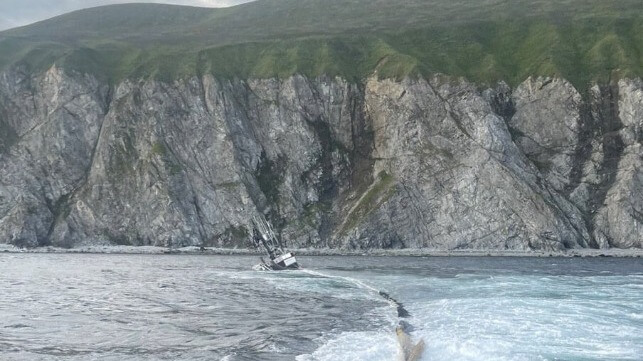NTSB: Master's Decision to Navigate Near Uncharted Rock Caused Grounding

The National Transportation Safety Board has determined that a master's decision to navigate in an area with uncharted rocks, close in to shore, resulted in the grounding and capsizing of a commercial fishing vessel off Kodiak last year.
On the morning of August 7, 2022, the purse seine vessel Challenger was operating off the coast of Kodiak Island. The captain, who had 15 years of experience in the area, chose to stay closer to shore in the lee of a cape in order to reduce the effects of weather. This was also a promising area for fishing, he believed, and he planned to set nets when he found a good spot. He was aware of a large uncharted rock in the area, having seen it at low tide before, but he did not think that it was nearby.
At about 0700, the captain was at the helm when Challenger struck a submerged rock. The captain checked for flooding and found water rising in the forepeak. One of the deckhands grabbed a portable dewatering pump and began pumping out the space. The captain made a call to another nearby fishing vessel to notify the skipper that the boat was in distress.
Seeing that the waves were moving the Challenger back and forth on the rock, the captain decided to back down and attempt to pull free in order to minimize the damage. As soon as he did, the rate of flooding in the forepeak increased significantly. The captain went belowdecks and started up both of the vessel's bilge pumps, but he quickly realized that they could not keep up with the rate of water ingress.
Four minutes after the grounding, the captain ordered the crew to abandon ship into the vessel's seine skiff, which was easily accessible and seaworthy. Two other nearby seiners launched their skiffs to assist, and they helped Challenger's crew to recover the valuable seine net off their stricken vessel. About six minutes later, Challenger capsized, though it remained afloat.
One of the responding good samaritan vessels, Sea Tsar, affixed a line to the capsized Challenger and began towing it to nearby Larsen Bay. Another vessel, Sea Ern, took over and completed the tow that evening.
Challenger was declared a total loss at a cost of about $600,000.
After the casualty, investigators attempted to find the uncharted rock, without success. The location that local fishermen reported corresponded to an area that was last charted before World War II - a degree of recency that is common for the remote waters of Southeast Alaska.
The Coast Pilot for the area recommended giving the shore a berth of at least one nautical mile, but the Challenger was operating within about 220 yards when it went aground. NTSB concluded that the probable cause of the casualty was the master's decision to navigate closer in to the beach, in an area where he knew there was an uncharted rock.
NTSB also noted that the forepeak had a non-watertight hatch into a void below it. Water entering through the hole in the forepeak flooded the void, reducing stability. If the hatch had been watertight, it would likely have prevented progressive flooding and capsizing, NTSB concluded. Watertight collision bulkheads are not required on vessels of Challenger's size.
No comments:
Post a Comment